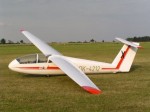 Blanik L-13
Blanik L-13
The L-13 Blaník is a two seater trainer glider produced by Let Kunovice since 1956. It is the most numerous and widely used glider in the world. In United States Air Force Academy service, it is designated TG-10C and is used for basic flight training.
The L-13 Blaník was designed by Karel Dlouhý of VZLÚ Letňany ca. 1956, building upon the experience gained with the Letov XLF-207 Laminar, the first Czech glider to employ laminar flow wing profiles. The L-13 was developed as a practical glider suitable for basic flight instruction, aerobatic instruction and cross-country training. This design concept was combined with true and tested technology: metal construction, NACA laminar profiles and many standard-issue components of the soviet aerospace industry.
The Blaník entered production in 1958 and quickly gained popularity as an inexpensive, rugged and durable type, which was easy to fly and operate. It was widely adopted in the Soviet bloc and was exported in large numbers to Western Europe and North America. Total production was in excess of 2650, or more than 3000 if variants are included. Nearly half a century after its first flight it is still the most common glider in the World.
In the cross-country role the Blaník achieved many two-seater World distance records during the 1960s in spite of having only fair performance.
The Blaník inspired other designs, notably the Démant and L-21 Spartak single-seaters developed to equip the Czech team in the 1956 and 1958 World Championships.
CharacteristicsThe effectiveness of the Blaník as a primary trainer is due to a blend of characteristics that facilitate progress of ab initio students towards solo flight, namely: slow landing speed, ample control deflections and an effective rudder. These are in effect typical of wood-and-fabric primary trainers such as the ASK 13, which the Blaník resembles in handling, though not in materials, construction and aerodynamics.
For this reason, pilots trained in the Blaník require differences training in a modern two-seater before transitioning to high performance plastic single seaters.
The Blaník is stressed for simple aerobatics. It cannot perform advanced maneuvers such as snap rolls (flick rolls in British English) and inverted flight is strictly single-occupant. Therefore, intermediate level aerobatic training in the Blaník must be done in solo flight with the instructor on the ground or in another aircraft.
There are two piloting issues that pilots should be aware of. The wheel retracts counter-intuitively, with the gear handle moving forward for wheel up and back for down (this is reversed on the L-23). More importantly, the spoiler and flap handles have the same shape and are close to each other. This has led to a number of incidents where pilots have mistakenly operated the wrong handle, particularly in the landing pattern. Instructors recommend that a positive visual check of the spoiler operation be made during the prelanding checklist, and that the pilot's hand stay on the handle right through full stop.
The Blaník empennages are vulnerable. The horizontal stabiliser is low enough to be damaged when landing in brush, and one must not push on the vertical fin when ground handling as it is not stressed to carry loads fore-and-aft.
General characteristics
- Crew: Two
- Length: 8.40 m (27 ft 7 in)
- Wingspan: 16.20 m (53 ft 2 in)
- Height: 2.08 m (6 ft 10 in)
- Wing area: 19.2 m² (207 ft²)
- Aspect ratio: 13.7
- Empty weight: ca. 292 kg (645 lb)
- Gross weight: 500 kg (1,100 lb)
Performance
- Maximum speed: 253 km/h (158 mph)
- Maximum glide ratio: 28
- Rate of sink: 0.82 m/s (161 ft/min)







